The Speeding Bullitt of Somerville
Sometimes Somerville really is a village. On my way home last Friday, I discovered the Co-Habitant, Somervillain and Brian P. engaged in what appeared to be an impromptu bike-testing party, after having crossed paths on their way home from work. The many other cyclists who rode by craned their necks with interest, because of course none of these were "normal" bicycles. Somervillain had his Bike Friday tandem, which he was riding alone. The Co-Habitant had his Pashley. And Brian P. had his Bullitt cargo bike. My own arrival on the swan-frame Pilen complemented the scene nicely. The sun was setting over the Peter Forg Manufacturing Co., bathing the street in that magical golden light. I had wanted to try Brian's cargo bike, and now was my chance.
The bike is a Bullitt "Milk Plus" model, made by Larry vs Harry. It is a Danish cargo bike, based on a traditional "long john" design - similar to a Dutch bakfiets, but with a longer and narrower cargo platform. Larry vs Harry market the Bullit as being fast and sporty in comparison to other cargo bikes. The bike is 245cm (96.5") long, 45cm (18.5") wide, and it weighs 24kg (53lb) unloaded. It has a 20" front wheel and a 26" rear wheel. Detailed geometry specs and blueprints are available here.
The frame is heavy-duty welded aluminum.
The frame is described by Bullitt owners as extremely stiff. I like the part where the main tube branches out to form the platform - there is something visually appealing about this junction.
The (optional) cargo box is plywood. It can be used to carry cargo or passengers and comes with a water-resistant cover.
The bike is equipped with disc brakes.
And an 8-speed IGH drivetrain. See here for complete specs.
The wide double kickstand keeps the bike unquestionably sturdy and is easy to activate.
Brian bought this bicycle from Splendid Cycles in Portland, OR, and they installed a dynamo hub with the Supernova E3 headlight and tail light.
He also replaced the stock racing-style saddle with a Brook Flyer, and he says that that the sprung saddle works well with the stiffness of the frame.
He replaced the stock mountain bike-style handlebars with North Roads,
and added a modified Civia rack from Calhoun Cycle with a set of Dutch panniers.
I found the overall look of the modified Milk Plus Bullittt extremely attractive and was looking forward to trying it. It felt well-balanced as I was walking it, which gave me hope.
The saddle is quick release and smooth to operate; I was able to adjust the saddle height myself.
The stem is also quick release, making it possible for different riders to adjust handlebar height to their tastes.
I was able to step over the Bullitt's top tube while wearing a skirt without having to swing my leg around the back; the standover height is similar to that of a large mixte. I was comfortable and ready to ride the bike... which, unfortunately, was not so easy! The main problem is that the Bullitt needs to gain momentum in order to become stable. When just starting or going slowly, the long front end fishtails wildly and the bike is difficult to control.
After a few shaky starts, I did manage to ride the Bullitt down the street and pick up some speed, only to falter when attempting to come to a stop. Luckily, the bike was easy to hold up once it started to fall over to the side, so I did not outright crash it into the ground. Not wanting to damage somebody else's shiny bicycle, I did not make further attempts. Not pictured here, but Somervillain tried the Bullitt as well with similar results- false starts, then finally getting it going, then dumping it when attempting to stop at the end of the street. There is a learning curve.
I understand the concept of having to get the bike up to speed in order to achieve stability. But unless I am missing something, this seems at odds with using it in stop-and-go traffic - which is what I thought cargo bikes are designed for... In any case, some riders may find operating the Bullitt more intuitive than others.
The Co-Habitant pretty much was able to ride it, though he described the same fishtailing sensation and said that he'd need a lot of practice to feel comfortable with it in traffic.
Brian handles the bike like a pro, making it look extremely easy. He reports having been able to ride it pretty much on the day it was assembled - sticking to local streets initially, then venturing into heavier traffic.
Looking at these pictures, it occurs to me that perhaps people with beards take to the Bullitt faster than people without. Based on our very scientific sample size of n=4 at least, that seems to be the case.
At this point, Brian has had the Bullitt for just over 2 months and enjoys it tremendously. It is indeed supposed to be faster and more maneuverable than other cargo bikes, once you get the hang of the handling. Brian lives atop of an insane hill that I would hate to tackle every day even on a roadbike. He finds the Bullitt manageable when cycling up it. Typical commuting speed is about 10mph, or faster with no cargo. Normally, Brian uses the Bullit to pick up his son from daycare and for groceries. He has also done a camping trip on it once, which he will soon describe on his website. When I asked Brian for critical feedback, he replied that the size made the bike unwieldy to walk - for example, when strolling with someone else on the sidewalk. There is also no good way to secure valuable items on the bike, making multi-trip shopping difficult. These issues are of course common to all cargo bikes.
The Bullitt Milk Plus with Brian's modifications is dashingly handsome, and just the right size for the kind of cargo we'd need to carry. If I could ride it, I'd be seriously fantasising about it. But while I can see myself quickly getting used to the Christiania trike I tried earlier, realistically speaking I cannot imagine feeling comfortable enough with the Bullitt to ride it in traffic. The slow-speed handling is just too quirky for me. Reactions to the Bullitt seem to greatly depend on individual bike handling skills and preferences. For those who can handle it, the Bullitt is a unique cargo bike option in the combination of speed, agility and load capacity it offers. But I would strongly recommend test riding this bike before buying.
The frame is heavy-duty welded aluminum.
The frame is described by Bullitt owners as extremely stiff. I like the part where the main tube branches out to form the platform - there is something visually appealing about this junction.
The (optional) cargo box is plywood. It can be used to carry cargo or passengers and comes with a water-resistant cover.
The bike is equipped with disc brakes.
And an 8-speed IGH drivetrain. See here for complete specs.
The wide double kickstand keeps the bike unquestionably sturdy and is easy to activate.
Brian bought this bicycle from Splendid Cycles in Portland, OR, and they installed a dynamo hub with the Supernova E3 headlight and tail light.
He also replaced the stock racing-style saddle with a Brook Flyer, and he says that that the sprung saddle works well with the stiffness of the frame.
He replaced the stock mountain bike-style handlebars with North Roads,
and added a modified Civia rack from Calhoun Cycle with a set of Dutch panniers.
I found the overall look of the modified Milk Plus Bullittt extremely attractive and was looking forward to trying it. It felt well-balanced as I was walking it, which gave me hope.
The saddle is quick release and smooth to operate; I was able to adjust the saddle height myself.
The stem is also quick release, making it possible for different riders to adjust handlebar height to their tastes.
I was able to step over the Bullitt's top tube while wearing a skirt without having to swing my leg around the back; the standover height is similar to that of a large mixte. I was comfortable and ready to ride the bike... which, unfortunately, was not so easy! The main problem is that the Bullitt needs to gain momentum in order to become stable. When just starting or going slowly, the long front end fishtails wildly and the bike is difficult to control.
After a few shaky starts, I did manage to ride the Bullitt down the street and pick up some speed, only to falter when attempting to come to a stop. Luckily, the bike was easy to hold up once it started to fall over to the side, so I did not outright crash it into the ground. Not wanting to damage somebody else's shiny bicycle, I did not make further attempts. Not pictured here, but Somervillain tried the Bullitt as well with similar results- false starts, then finally getting it going, then dumping it when attempting to stop at the end of the street. There is a learning curve.
I understand the concept of having to get the bike up to speed in order to achieve stability. But unless I am missing something, this seems at odds with using it in stop-and-go traffic - which is what I thought cargo bikes are designed for... In any case, some riders may find operating the Bullitt more intuitive than others.
The Co-Habitant pretty much was able to ride it, though he described the same fishtailing sensation and said that he'd need a lot of practice to feel comfortable with it in traffic.
Brian handles the bike like a pro, making it look extremely easy. He reports having been able to ride it pretty much on the day it was assembled - sticking to local streets initially, then venturing into heavier traffic.
Looking at these pictures, it occurs to me that perhaps people with beards take to the Bullitt faster than people without. Based on our very scientific sample size of n=4 at least, that seems to be the case.
At this point, Brian has had the Bullitt for just over 2 months and enjoys it tremendously. It is indeed supposed to be faster and more maneuverable than other cargo bikes, once you get the hang of the handling. Brian lives atop of an insane hill that I would hate to tackle every day even on a roadbike. He finds the Bullitt manageable when cycling up it. Typical commuting speed is about 10mph, or faster with no cargo. Normally, Brian uses the Bullit to pick up his son from daycare and for groceries. He has also done a camping trip on it once, which he will soon describe on his website. When I asked Brian for critical feedback, he replied that the size made the bike unwieldy to walk - for example, when strolling with someone else on the sidewalk. There is also no good way to secure valuable items on the bike, making multi-trip shopping difficult. These issues are of course common to all cargo bikes.
The Bullitt Milk Plus with Brian's modifications is dashingly handsome, and just the right size for the kind of cargo we'd need to carry. If I could ride it, I'd be seriously fantasising about it. But while I can see myself quickly getting used to the Christiania trike I tried earlier, realistically speaking I cannot imagine feeling comfortable enough with the Bullitt to ride it in traffic. The slow-speed handling is just too quirky for me. Reactions to the Bullitt seem to greatly depend on individual bike handling skills and preferences. For those who can handle it, the Bullitt is a unique cargo bike option in the combination of speed, agility and load capacity it offers. But I would strongly recommend test riding this bike before buying.

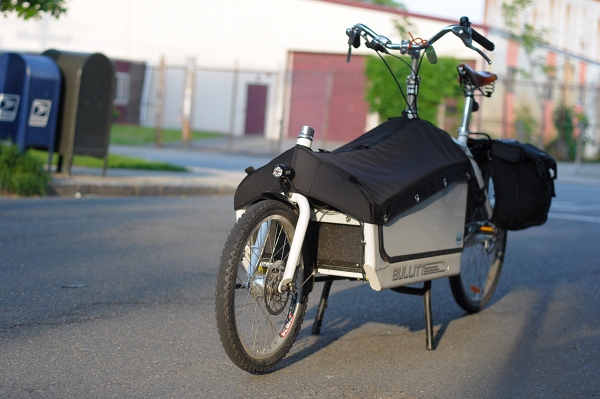
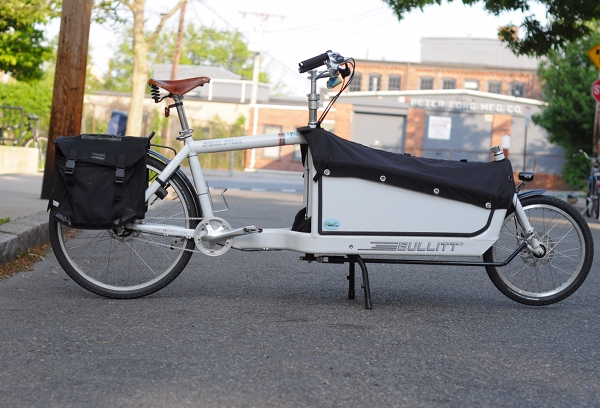
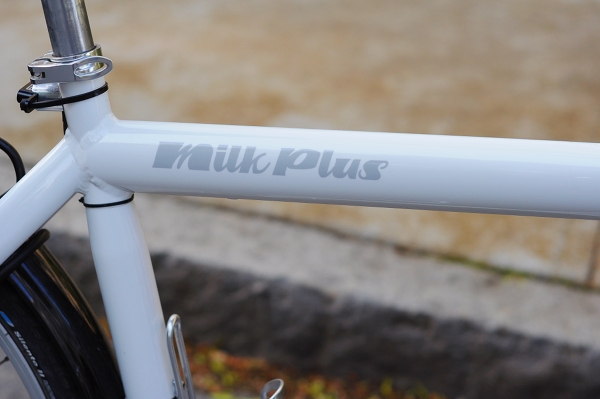
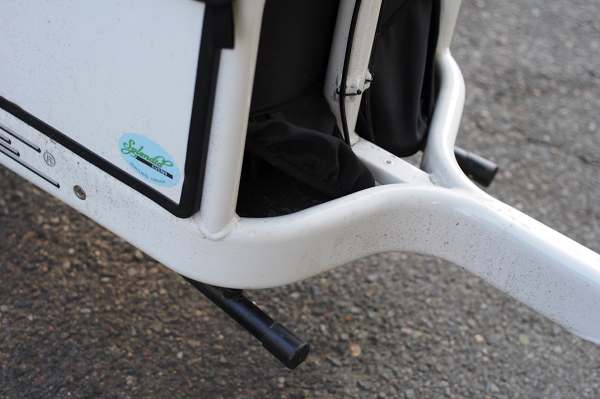
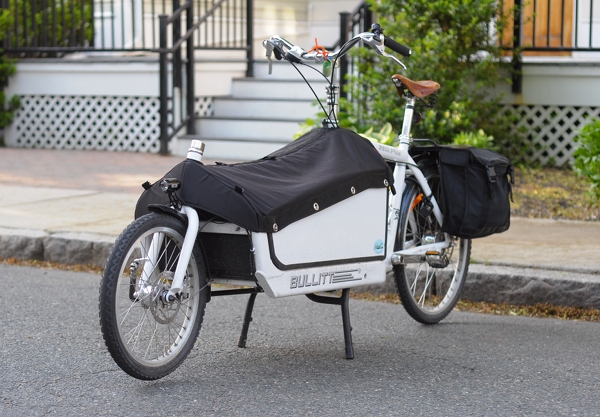
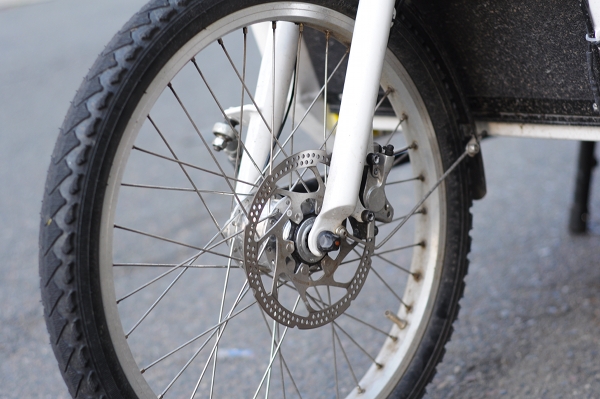
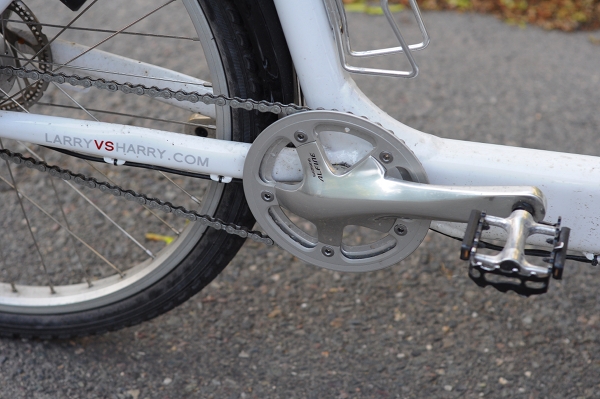

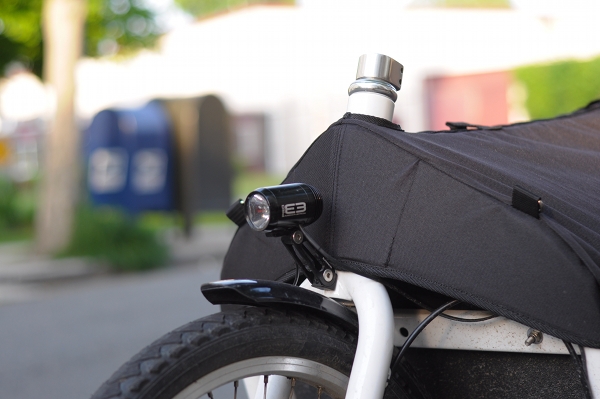

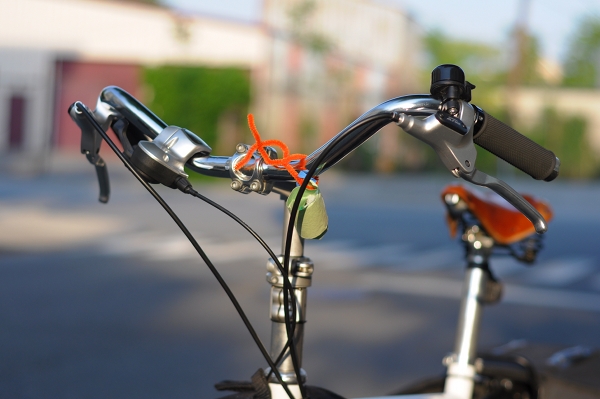


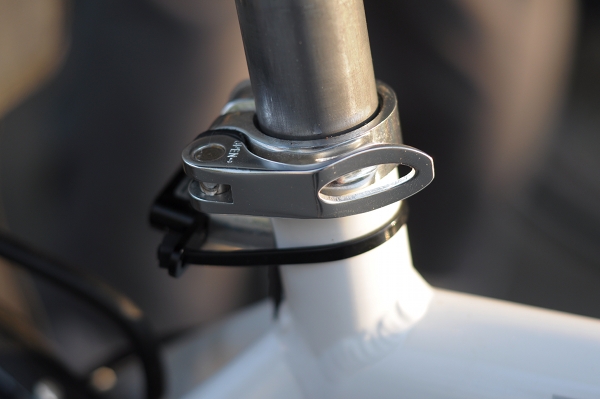


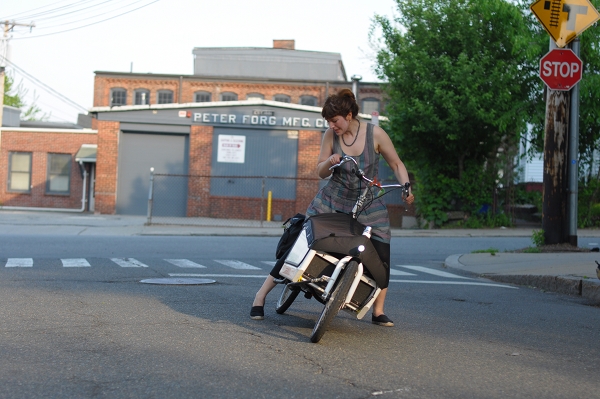


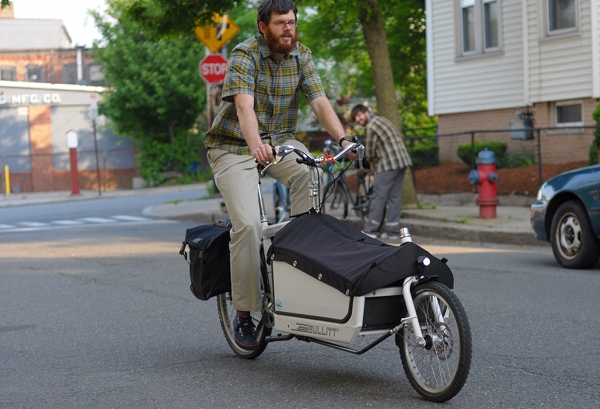


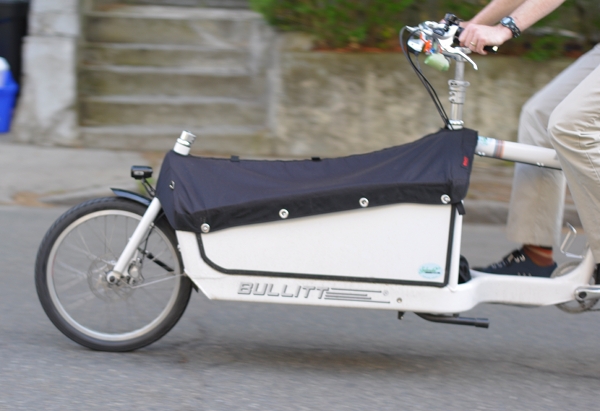
I've had my Bullitt for about six months. I did the lion's share of riding on it for the first week, covering about 600 miles on tour, while the rest of my riding has basically been to the market and back.
ReplyDeleteAs you mention, it takes getting used to, but I really haven't had the fishtail issue you mention (or perhaps I don't notice it). It does seem a bit more solid when loaded. I'd also point out that lockable boxes are available to mount on the frame, which could provide worry-free shopping. I bolted a big plastic box with lid that I found at the Container Store, and that seems to do the trick for me.
I have a few small criticisms of the bicycle. The frame design is aesthetically pleasing, but I find the rough, chunky welds a bit off-putting. (I'm sure part of the issue is cost.) It's too bulky to store indoors, and big when parking, so one ought to think through the end-to-end trip parameters when using it.
Otherwise, it has been really useful -- I loaded a broken desktop computer to transport service today, for example -- and easy to use.
The fishtailing issue you describe is not typical. I did not experience it during my very short test ride.
ReplyDeleteBut I've heard from owners that the steering damper is a must, the steering being quite "quick" and sensitive, which can be bothersome at high speeds.
Why did you put a rack and panniers on a cargo bike?
ReplyDeleteHandsome bike!
ReplyDeleteI wish there were more local (boston) places to try one. I think that even more than most types of bikes, the handling is very different between bikes within the "cargo" category. I've tried a Workcycles Bakfiets, and it was fairly intuitive. I know that Clever Cycles offers a cargo bike rental service (Uhaul for the carfree). That kind of thing would let you try different types under real world conditions for several days at a time.
I'll just have to schedule a trip to Portland (OR) when I really decided to buy one I guess :)
Using a "beard" to improve biking skills must be a universal phenomenon given your data and mine. The resulting formula: beard = awesome bike "skillz" (yes, with a "z").
ReplyDeleteI think it is safe to extrapolate by adding this conclusion: less beard = less bike skillz. Needless to say, less bearded individuals lack the testosterone-induced manliness to enjoy biking optimally. Therefore, those who are "testosterone-disadvatanged," should listen to those with more testosterone. It is science.
(note: This tongue-in-cheek comment is not meant to be critical of Brian and his beard, or any other bearded man in general. It is simply reflecting some tragically primitive logic endemic to this culture. *Unrelated to the content in this post!*)
Ha, the 'ville is indeed much like a village. I'm increasingly running into people I know (which also increasingly includes cycling-related friends) and its those chance encounters with clusters of velo obsessionists like you, the co-hab and Brian that make it such a neat place to live.
ReplyDeleteAs an aside, I can totally identify with that orange pipe cleaner wrapped around the handlebars. Brian, I think I know exactly what that's for! I keep a stash of them in my Bike Friday pannier!
Kid toy I thought? What is it for??
ReplyDeleteIf I may take a turn at trying to describe what's difficult about this thing:
ReplyDeleteJust as you get started, the bars are very light so any touching of the bars on your part (as with slight leaning) will impart a sudden and unexpected trajectory change of the front of the bicycle. And it's super-maneuverable, for example Brian can turn this thing around in half a street-width, I think I have twice the turning radius on my Pashley.
Anyway, this steering responsiveness causes you to overcorrect the turn and starts this cycle of going left to right to left to right again and you lose control of the bike.
At least there is a tendency to do that.
You have to be like "not gonna yank the bars, just pedal pedal... here we go," once you hit 2mph you're no longer unstable.
Re: My question about putting on a rack and panniers - I ask because if you want to carry anything on that bike it is the singularly worst place one could choose. The more weight you carry at the back the more likely it is to lift the front wheel and harm the handling. Taking the cover off the cargo space and shoving the panniers there will improve things.
ReplyDeleteRe orange pipe cleaner: Heck, if I had to ride in a container I'd want arts & crafts supplies to play with too!
ReplyDeleteI’m wondering exactly what it is like to steer in traffic. Regular bikes steer directly below and are instantly responsive to the input of your hands. What is it like to steer 3 or 4 feet ahead of where you are? Is it harder to see and react to bumps in the road?
ReplyDeleteI would like to try riding it myself. I think I would do OK, since I just have a mustache …
Affordable Luxury
Mike--Brian seems to pilot this thing with such grace and artistry that it's a shame to really suggest he change anything about his setup in order to improve his steering or things. :)
ReplyDeleteThe unique handling is somewhat typical of these bikes, I think, and just requires some "re-calibrating" of your steering instincts. Jan Heine had a good explanation in the BQ review of the Francis Small Haul: a bike is balanced by constant, minute adjustments that essentially move the bike back "under" itself as it starts to tip> With the front wheel so far away, a relatively larger steering input is required to move the bike's center of gravity the same distance sideways to re-balance it. I think I've got that right? Anyway, combine this with the geometry of the linkage between bars and front wheel and it is easy to over-correct the steering inputs at low speed, and "fish tail" (though it's more accurately a "head shake" :)
ReplyDelete@cycler: If you are looking to test a cargo bike, I know Bicycle Revolution in Philly has CETMA cargo bikes, and I think Adeline Adeline in NYC sells Bakfiets, though I'm not sure if they have them available for test rides. Not exactly Boston, but it beats flying to Portland...
I have seen these bikes locally at Splendid Cycles and read a comprehensive comparison test of this versus a couple of other cargo bikes in a transportation-centric cycling publication. the Bullet faired very well against it's competitors. I do like that this bike can be customized (internal hub not required, brake options, etc). Also, the cargo carrying area seems useful without being overly wide (the trike). I have had a couple of unpleasant encounters with vehicles because of the width of my Yuba with one pannier. The trike is much wider than my Yuba configuration. In the review I read of the Bullet, it got kudos for climbing and load carrying ability. As we have learned from riding 'uncomfortable' road-ish bikes, sometimes going through the learning curve is worth the effort.
ReplyDeleteAdd a rear wheel electric assist and this could be a very useful car replacement for a lot of people.
Hated the handling during my first brief, unloaded wobble around the block, but *loved* the bike on my second attempt, 24 hrs in Portland with kids in the box. The weight helped, but I really do think there's just a brief, steep learning curve on this bike, more so than with other front-loaders.
ReplyDeletehttp://totcycle.com/blog/larry-vs-harry-bullitt-family-style.html
"The fishtailing issue you describe is not typical. I did not experience it during my very short test ride."
ReplyDeleteAll 3 of us (MDI, Somervillain and myself) experienced this issue, and Brian has said that a large portion of people who try the bike report the same. Brian himself found it relatively easy to handle from the start. His wife, on the other hand, is not yet able to ride the bike in traffic, after 2 months of ownership.
I think the safe way to put it, is that some people will have issues with the bike's handling and it's important to try before buying.
I may be way off here, as I have absolutely no experience on any long bike, but it seems with the new handlebar and upright seating position, the Bullitt is somewhat unweighted in the front, especially with the smaller framed unbearded riders. This leads to the fish tail as described. With a heavier torso (due to beard size) and more weight on the front wheel, this fish tail is less pronounced. Any takers on my theory?
ReplyDeleteThe readers here are great! You all have mostly answered all of my questions, thanks.
ReplyDeleteAnon 10:58 & MDI describe the handling well. The handling improves with weight up front, less movement of more weight rebalances more quickly. I took a video from a camera mounted to my hbars over the weekend. The amount of small hbar adjustments I do unconsciously is dizzying. But I can control it very well, avoiding put holes, light trail riding, lane splitting, etc.
Note that when my son is on board I ride much more slowly and I'm regularly avoiding pavement irregularities to improve his ride, though I am also on quieter side streets and often take the lane so I have more width to work with.
@M_Perkins, The wheel being about 3' in front of you impacts perspective, but not negatively. It is like you are viewing yourself cycling from a few feet behind, like on the car video games where you view the rear of the car you are driving, rather than through the windshield. Giving you a somewhat broader perspective of your surroundings.
@Mike, You are correct about not wanting to put weight in the rear, if I out more than ten pounds behind me, I have much more than that in front of me. I did not anticipate putting panniers on. Yet the initial purpose of the bike was to carry my son, and the infant seat occupies the vast majority of the front box. I needed the panniers for the diaper bag and sundries from daycare. I also used them in my S24O camping trip last weekend.
@Julian, your balanced reviews of the Bullitt and other bikes helped me choose a cargo bike. thank-you!
@Cycler, there are many cargo bikes to choose from. I second the desire to have a shop nearby that has them to try, buy and borrow. I like the 'UHaul' idea.
@Veloria: my wife has only ridden it twice since I've owned it (once on the bike path and once to the cafe early Sunday). She is on the timid side of cycling, but she will probably be quite comfortable after a few more rides, though I do want to make a few more modifications to improve her riding comfort.
Re: Pipe Cleaner Toy, during the New England Bike Expo we had a family bike show and tell, and a friend's daughter decided my bike needed some decoration. Here decoration has been quite robust and has survived over a month despite being living outside. I also carry other baby toys on a regular basis.
cycler - Portland Velocipede in ME has bakfietsen and the Gazelle Cabby (they just announced on Twitter that the latter is on sale), but sadly no other cargo models. Even in Portland OR, no one shop has all the cargo bikes, as far as I know - but I guess one could go to Clever Cycles & Splendid and get a sense of most of them.
ReplyDeleteIn Vienna, my friend Wolfgang expanded his bike moving company Heavy Pedals to sell and rent cargo bikes, and he does pretty much carry them all now! Too bad I won't be there this summer to test them.
Brian, my daughters use the pipe cleaners to "buckle" their small stuffed "friends" to the handlebars! (I would describe it more as "choking" them, but I keep that thought to myself) :-)
ReplyDeleteFor New Yorkers or those visiting:
ReplyDeleteAdeline Adeline: Workcycles bakfietsen and Christiana trike. They're the nicest people ever about test rides.
Rolling Orange: de Fietsfabriek bakfietsen.
Hub: George Bliss is a long-time bike builder of crazy and crazy awesome cargo trikes, bikes and pedi-cabs. I think he uses a worksman frame but I bet he can do pretty much anything. They also carry Achielle, so they might have their insanely beautiful cargo bikes. I don't know, though!
Paul Fuster is a custom cargo bike builder in Brooklyn. I ran into a guy with one of his bikes and it looked super cool.
I'm sure there are more . . .
I had the good fortune to try Brian's bike out myself a month or so back during a strategizing session for how best to anchor the baby seat. I too struggled for the first launch, literally making it about 10 feet before having to plant a foot and stop. But something occurred to me after that first try that made Attempt 2 immediately successful: you have to steer "more" than you think you do. That is, to enact (for example) a 10 degree right turn, you have to turn the bars something like 25% farther to the right than you are used to doing on a typically-framed bike. As soon as I pushed off for Attempt 2, I just forced myself to turn much more than I would normally do, and the bike magically did exactly what I wanted it to. I was able to u-turn in his street several times and go back and forth with relative ease once I made that manual mental correction. It was a little like speaking through a translator, but I am sure it would become automatic for me in short order. And while it might feel like a lot of work, I would say the potential payoff is pretty big... that's a lot of cargo capacity in a very maneuverable package.
ReplyDeleteAs for the panniers, I would've done the same thing. It's nice to have something that's rain proof and easily / quickly removable for when you get to work, etc. And I too know the pain of seeing all your hard-won cargo storage vanish under the hulking mass of a modern child car seat.
Last point: I am almost entirely beardless. So it can be done.
I think wade is right. Changing to a more upright riding position, especially w a shorter light torso is going to make the bike more "scuirrely".
ReplyDeletebadmother
Barb from Splendid Cycles here:
ReplyDeleteIt's unfortunate that the bike's handling is being judged by a short test ride. There IS a learning curve with this bike, but it has to do with retraining the brain to its steering dynamics. In fact, after riding this bike for a few miles my brain also has to readjust to getting on a standard bicycle...that's just how brains typically work. Granted, that adjustment may not be as noticable on other cargo bikes...However, I'm not bearded nor heavy (unless 130lbs is heavy) and after adapting I've found this bike to be the most rock-solid handling bike I've ridden, cargo or otherwise. It did take a few rides but now I am very comfortable in all kinds of traffic, even the bike-ped packed Sunday Parkways events here in Portland. I've become comfortable enough to use the bike in just about any situation; I've carried no load, heavy loads (200+lbs), including adults shifting their weight. Despite the initial wobbliness, I now go to the Bullitt when I need a bike that's steady and trustworthy in its handling. I trust it more through gravel, sharp corners, and potholey streets than any other bike I've owned or ridden.
Some folks get it right away, some folks need a few miles, with no correlation to cycling experience or bike handling abilities. I've sent many test riders off on the bike and know that riders who relax and look where they want to go (not at the front wheel) pick it up more easily.
Thanks for letting me chime in; I did not just because I sell Bullitts but because I REALLY enjoy riding them too.
Barb - Thank you for chiming in. Manufacturers and sellers are welcome to participate in discussions and your experience is valuable.
ReplyDeleteThis post was by no means meant to be a definitive review of the Bullitt, it simply described my subjective initial impressions of the bike. I also made sure to include the owner's feedback, precisely because my experience with it was limited. While it is possible that with practice I'd feel comfortable on the Bullitt, I did not feel like practicing on (and crashing repeatedly) somebody else's bike. Also, I am just not the kind of cyclist who is comfortable even attempting to get used to the sort of steering I experienced - overall I'd prefer something more stable. Faltering in traffic and veering into an oncoming car lane because I lose control of my bike is no joke.
While looking for other reviews of the Bullitt, I've noticed that whenever its steering is criticised or even described as quirky, there are readers (usually owners and sellers) who get defensive. I don't think that's necessary. We will all experience different bikes and trikes differently and that's just something that needs to be accepted. Some cyclists will feel comfortable experimenting with steering that initially frightens them, while others will not.
I love seeing all of these great bikes around town! (and it's possible my daughter was responsible for that beautiful orange pipe cleaner...)
ReplyDeleteI do think any cargo bike requires getting used to, even the more straightforward long bikes do, especially fully loaded. I had wondered how Brian was going to solve the inevitable baby gear problem with the seat taking up the bulk of the box. I would have added panniers as well.
Re upright handlebars and weight distribution: I weigh 125lb, probably 1/3 of which is in the part of my body that would be affected by the change in handlebars. Given that the bike carries so much more weight than that in the cargo box, I don't see how a few pounds forward or backward in the cockpit area could affect handling all that much. Am I missing something?
ReplyDeleteI like that 4th photo up from the bottom, where at first it appears almost like co-habitant has been shrunk down to a miniature size and is standing on the cargo canvas cover. An optical illusion.
ReplyDeleteIt might make for some interesting bike photos if you actually used photoshop to shrink characters down to a miniature size to point out certain close-up bike features.
Fun blog, as always...
OMG it does look like he is standing on the tarp and Brian is transporting a mini version of him! Thanks for pointing it out : )
ReplyDeleteI have nothing to add but say " yay for cargo bikes." I def could see you with this one if you felt comfortable enough to ride it. It's lovely.
ReplyDeleteYou're on a real cargo kick of late. Now that you've tried front loaders may I suggest checking out a rear load cargo bike? I commute every day (about 15 miles a day) on a Madsen bucket bike. I had test ridden bakfietsen and an xtracycle before purchasing the Madsen. It definitely handles the most like a regular bike and is pretty hybrid-like in handling.
ReplyDeleteComing from a road racing background I was pleased with the handling of the Bullitt vs. the Bakfiets. The seat and head tube angles differ drastically from the two brands of bike. I have no issue when swapping from a road bike to Bullitt or vice-versa. The primary learning curve adjustment when riding my Bullitt was to not look at the front wheel when steering, thus the boxes I've made do cover the wheel from view. The bike was designed to carry cargo and feels more stable with 30+ lbs on board than without a load. My guess too is that adjusting geometry with higher rise swept back bars adds to the complexity of handling. Again, that set up would be more natural on a bike with a more slack seat and head tube angles. But whatever works for the rider is what works. The bottom line is that this cargo bike "revolution" simply makes bike riding more fun for everyone.
ReplyDeleteThe security issue could be solved by making hinged panels that fold down over the side when not in use and latch together at the top with a lock... I can see it in my brain and it TOTALLY works awesome(of course I also see gangs of spider monkeys riding miniature Bullitts and doing monster wheelies in my brain as well. That's pretty awesome too).
ReplyDeleteSpindizzy
I would nest in it and hiss menacingly at the passers-by. Just like I do from the window. *hiss*
ReplyDeleteDoes this bike have a steering damper ? I can't say from the pics.
ReplyDeleteAccording to several owners, it really helps to smoothen things.
I agree the "non linear" steering is weird at first. It just didn't really bother me.
@arevee: The effect of electric assist on a cargo bike is shown here:
ReplyDeletehttp://www.youtube.com/watch?v=rHP8mHbDVOM
and here:
http://www.youtube.com/watch?v=aL5WiVK0PiY&NR=1
(speeds are in km/h not miles!)
The comment says "without exerting myself".
Dutch bicycle manufacturer Sparta recognizes this niche and advertises with this:
http://www.youtube.com/watch?v=XAZmSi-13II&NR=1
Question: "Why not doing your shopping by bike instead of car?".
Answers: "Too heavy, too cumbersome, too tiring".
And after trying the electric assist: "We never realised it could be that easy".
It sounds like the steering might be similar to that of a long-wheelbase recumbent, also a favorite activity of the bearded set. Despite lacking a beard (though meeting the prereqs), I rode one quite a bit last summer. I could ride on the first day, and I could ride it safely after a few more days -- sufficiently that I rode it on a tour. Now I'm bored of it (I bought it third-hand out of curiosity) and am back to my trusty Trek 520.
ReplyDeleteSteering a tandem is also a bit odd at first but then becomes natural. Then a non-tandem seems twitchy for a little while. A tandem lacking a stoker magnifies the twitches, so it provides good handling practice in general.
Switching between wheel sizes on unicycles also presents similar experiences at first: each seems odd after riding the others.
But I've found that with time, switching between vastly different vehicles becomes second nature -- so much so that the various types also become less "fun" because they lack novelty. That said, I do often get a kick out of the sheer perfection (for me) of my 520 setup, despite the many miles on it. And there is some joy in being the master of a given vehicle.
Philippe - I don't think that it has a steering damper.
ReplyDeleteAaron - I like switching between road bikes and upright city bikes, as well as between different types in each category. But the transition to longjohn and back would probably be too much for me at this stage.
"But the transition to longjohn and back would probably be too much for me at this stage."
ReplyDeleteWhen I finished up my tour from Copenhagen to Amsterdam via Bullitt, and then rented a standard-issue Dutch bike, I remember being nearly unable to control it. It felt very squirrelly, and I immediately blamed it on the design. But then, when I got home, my trusty road bike felt squirrelly, too, so I figured it had to be all in my head. Now, after a tiny bit of practice, I find it easy to switch.
I think it takes about ten miles -- an hour -- to get used to it.
examinedspoke - It's not about "blaming" the design. That would be like blaming a roadbike with dropbars for not being upright. It is merely a description of the transition to this particular bike's handling being more dramatic (for me, at least) than the transition to, say, the Christiania cargo trike I tried earlier.
ReplyDeleteWhen the retailer from Splendid posted her comment above, she wrote that it takes time to adjust to the Bullitt's handling, and added that "...[g]ranted, that adjustment may not be as noticable on other cargo bikes..." To many of my readers, that last bit is a crucial piece of information that I believe is worth being aware of.
Your description of riding the Bullitt sounds remarkably like my first of my two experiences riding a tandem. I was the "captain", and even though the "stoker" (a blind woman) was keeping a good pace, the rear felt as if it were "fishtailing," no matter how straight a line we rode.
ReplyDeleteYour description of the slow-speed handling sounds just like the first trip I took on a bakfiets last fall. After that, I put a couple of dumbells in the box, and that helped a bit. One ride around the block, and I recall having minor concerns about being able to corner in a predictable line. Then I tried it with the three-year-old on the bench. Mercifully, he stayed still on that first trip, and it became very easy to control the bike.
ReplyDeleteI also recall the bike tipping when stopping problem, which probably happens for some people more than others, because of previously-established dismounting habits. If you happen to set your foot down with your bike upright as a matter of course, it probably wouldn't be an issue. This makes little difference on any light bicycle, but is very important on a two-wheeled cargo bike. I remember giving my wife two tips on riding it after my first few minutes: go fast, and don't let it tip when you stop.
It didn't take long before I had no trouble handling the bike, and most of my dismounts now are done without stopping (the lack of a top tube on the Van Andel bakfiets is nice) -- I just swing a leg across and hop down and start walking the bike. Even the kids violently throwing their weight around is merely annoying. In fact, I'd say I'm comfortable cornering harder on the bakfiets than I am on my other bike.
As far as posture affecting the steering, my experience agrees with Velouria -- there's no way I could lean far enough forward to make a significant shift of the center of mass to help the steering. In fact, I suspect that I would have found a Bullitt slightly more difficult to control on a first outing; having none of my weight supported by the handlebars may have made it easier to make quick, large steering motions in order to keep balanced.
Brian, just wait until winter comes, and you're making a trip on new-fallen snow with an empty box. That's when things get exciting!
Merlin - I'm a little confused, are you describing a Bakfiets or a Long John?
ReplyDeleteI cannot confirm this as I have not yet tried a Bakfiets, but I've been told by multiple people that the handling is different from the Bullitt - i.e. Bakfietsen are supposedly *easier* to maneuver at slow speeds and have a quicker learning curve. Their construction differs from Long Johns, so it's plausible. I will report back after I try one.
@ Phillippe, it doesn't have a steering damper. I might see the benefit if it shimmied at higher speeds, which it doesn't, but at lower speeds it requires regular wheel adjustments and a damper may make that more difficult. Yet, that also suggests the difference between the Bullitt and a Gazelle or similar. The Bullitt seems to require more attention to steering inputs for optimal control, resulting in more performance oriented handling, while the Gazeelle cabby that I tried last year seemed more sluggish yet was very easy to ride, it didn't have a damper either.
ReplyDelete@Merlin, I do like low top tubes, though I have learned to dismount in motion with a small load fairly easily. The standard top tube has been useful to make the bike more useable for touring. I took it on a small camping trip last weekend and it worked very well (http://bummels-jaunts.blogspot.com/). I'm looking forward to longer tours, where I might even consider putting drop bars on it. I agree the body position has less affect when center of gravity is measured in feet not inches. I already have my eyes on Schwalbe Marathon studded snow tires that come in the two sizes at I need, from Peter White.
@Veloria, what is the difference between a long-John and a bakfiets? I've always understood they were same. I might see a difference in handling design since their recent histories are a bit different, the danish long-John used primarily for cargo and the Dutch bakfiets used primarily kid-carrying. The two users, couriers and parents, have very different outlooks on riding around town.
I would love to try these various cargo bikes side to side. I'm working on a Kidical Mass event on Highland Ave in Somerville on July 24 when the street will be closed to motor traffic. I'm working to get as many cargo & family bike owners to show up and share their bike experiences first hand.
The bakfiets that I have is a Workcycles Cargobike Long (a version of the Van Andel bakfiets). It is a long john type bicycle -- two-wheeler, steered via linkage to the front wheel. "Bakfiets" is a general term referring to any kind of bike with a "box", including many tricycles. The handling issues with my bike and Brian's should be the same, but quite possibly of a different magnitude. Body position, steering range, and weight may differ significantly, but since I've never even laid eyes on a Bullitt in person, I can't offer a comparison. And even if I tried one now, it wouldn't be the same as doing so with no long john experience.
ReplyDeleteBrian -- I'm surprised to hear that the top tube on the Bullitt is low enough to swing your leg across; it looks really high to someone who's used to just the flat boom at the height of the bottom bracket. I do have to lift one knee slightly, but only to clear the nose of the saddle... I highly recommend the Marathon Winter tires (I got mine from Peter, as well) but with a couple of inches of unplowed snow and an empty box, I have very little to no fine steering control. Where I go in those conditions is determined mostly by the ruts left by cars, rather than where the front wheel is pointing. The studs are great for hard-packed snow (we have that for at least four months here in Winnipeg) and ice, but they have no effect on loose snow, and the tread on the Marathon Winter tires isn't deep enough to make much of a difference, either. I don't mean to discourage you at all, though; I definitely think those tires would make a huge difference in a Boston winter, with all the melting and re-freezing. I changed the tires on my bakfiets near the end of April, then had to ride without the studs during and after a snowstorm on May 1; there was a very big difference.
And about the top tube: I'm curious -- what about it makes it more usable for touring? Not that I think the Bullitt doesn't offer advantages over the Van Andel for this purpose, but I can't think of anything I'd use a top tube for on my cargo bike.
Phillippe & Brian: The Workcycles Cargobike also doesn't have a steering damper, and I don't think there would be a benefit to having one.
@ Merlin, I prefer low TTs on city bikes for casual dismounts in pedestrian areas. The TT is low enough on the Bullitt that you could get your foot over (comes to my knee on the downstroke), but I dismount over the rear panniers. After I got used to it, it became very easy to do so, even in crowded pedestrian areas. I suspect that is because the Bullitt has enough weight and a low center of gravity that my swing isn't unsettling. If I wanted to use a cargo bike solely in the city, I would probably have bought one with a low TT.
ReplyDeleteFor touring the frame stiffness that a horiz TT provides distributes pedaling input to push the box more effienctly, especially over uneven ground which I enjoy traversing. I believe this is noticeable over longer distances, but notnso much around town. Jan Heine provided a good description of this affect while discussing the Metro-Fiets design for his Oregon Manefest article.
Ah, I see. I've never been able to detect any kind of flex in the bakfiets, probably because it's just a massive steel boom, unlike the much lighter aluminum Bullitt. I thought you meant that you had some other use for the top tube, not simply as a structural support.
ReplyDeleteFor those still reading through the comments, there is now a test ride report of the bakfiets here.
ReplyDeleteI've owned a Bullitt for almost three years now.
ReplyDeleteIt does take a little while to get used to the steering/balance. For me, a not especially skilled cyclist, it took about 5 minutes before it felt perfectly comfortable and natural, and I had no qualms about riding it in traffic.
It's as easy to ride slowly as any other bike. I can ride it at walking speed on a crowded sidewalk, no problems.
I don't have a steering damper on mine, and have had no qualms about taking corners at 45 km/h (30 mph). But after three years the ball joint on the steerer has become worn, which is creating some front-wheel wobble on fast corners. But this is just normal wear and tear - time to get a new ball joint I think.
I've spent some 35 years riding lightweight road racing bikes. But I also used to ride a 400cc Yamaha motorcycle. Soon after learning to ride the Bullitt, I realized that it handles just like my old Yamaha! So of course there's a learning curve, where you learn new (exaggerated) steering inputs at low speed, but also: "reverse" steering inputs at high speed. This is key if you want better control of the Bullitt at high speed. Just like a motorcycle, you "push" toward the direction you want to go in, essentially counter-steering. It causes the bike to lean towards the direction you want to go in... your turning is accomplished by leaning. This matters at speeds over 25MPH especially.
ReplyDeleteMore than anything else, the handling is affected by the wheelbase. I think weight and position on the bike have little to do with it. Once you're used to it, you'll have the same degree of control as any other bike. For me, I enjoy the "normal" narrowness of the Bullitt, as I feel just as free on it in traffic as on a regular bike (being able to squeeze through tight spots).
I've been riding my Bullitt for over a year and I love it. Switching back to my racing bike is funny, because then for a few miles I'll be all squirrelly like a novice again!
My one gripe with the Bullitt is the lack of rack mounts in the back - I finagled a rack on there with panniers, but it took some creativity and metalwork. Panniers are essential if you want to transport kids in front - which is the whole reason we got the Bullitt. I bet most people in the USA buy the Bullitt for that purpose. Give us racks!
Cheers,
Boris
Interesting reading, but there is no mystery about one key aspect of manoeuvrability, the turning circle. The turning circle is determined by wheelbase and the maximum turning angle of the front wheel. The Bullitt and the Danish long john it is derived from have a very long wheel base and the front wheel steering rod limits the wheel turing to about 45 degrees. This gives the Bullit a very large, over 16 feet (5 metre) turning circle. (delta)Tricycles generally have much better front wheel turning angle and shorter wheelbase, giving them a much smaller turing circle. They also have no low speed balance issues, giving them vastly superior manoeuvrability.
ReplyDelete